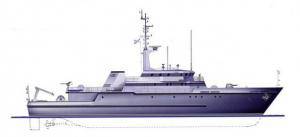Head Minesweeper of a new type for the Russian Navy to be laid at the Sredne-Nevsky Plant
 The solemn ceremony of laying the main anti-mine ship of the base zone of the new generation of the 12700 project “Alexandrite” factory number 521 will be held on September 22 in the shed of the Sredne-Nevsky shipbuilding plant.
The solemn ceremony of laying the main anti-mine ship of the base zone of the new generation of the 12700 project “Alexandrite” factory number 521 will be held on September 22 in the shed of the Sredne-Nevsky shipbuilding plant. High-ranking representatives of the command of the Russian Navy, United Shipbuilding Corporation OJSC, which includes the SNSP, administration of St. Petersburg, are invited to lay the ship's hull unique for the domestic shipbuilding industry, the hull of which is made of monolithic fiberglass. In honor of this event, a traditional cannon shot will be fired from the Naryshkin Bastion of the Peter and Paul Fortress, and the sleeve from it will take an honorable place in the museum. stories factory.
The ship has a unique, the world's largest body of monolithic fiberglass, formed by vacuum infusion. JSC SNSZ is the only plant in Russia that owns this technology and is the only one in the world who can create monolithic hulls of this size. The advantage of the hull is higher strength in comparison with steel hulls, which provides greater survivability of the ship when searching for mines. The service life of a plastic case is much longer than that of a low-magnetic steel case, and the weight is much less.
The lead ship is planned to be launched in 2012, after which it is expected to order a series of such ships for the Russian Navy. Project 12700 PMO ships in the near future will become the basis of the Russian naval anti-mine forces fleet.
The base minesweeper of the 12700 project, the Alexandr cipher, was designed in St. Petersburg by the Central Marine Design Bureau Almaz, taking into account the latest global trends in the field of mine defense. The 12700 project provides for the formation of a mine control circuit using the latest, highly efficient sonar stations deployed as the ship itself, and on remote-controlled and autonomous underwater vehicles, an integrated bridge system, the main command post — an automated control system for ivominnymi actions. However, the ship will be able to use the traditional sweeping arms. An important feature when creating the project is that it was originally provided for a system of ships and vessels on the basis of a unified body of fiberglass.
Middle Nevsky Shipyard was founded in 1912 year as Ust-Izhora shipyard for the construction of warships for the Russian fleet. Now the plant builds ships and vessels for both military and civilian customers, including foreign ones.
Reference: The main project TTE anti-mine ship project 12700 "Alexandrite":
Displacement full about 800 t;
Main dimensions: length - more than 50 m, width - about 10 m, draft - about 3 m;
Travel speed - 15 knots, cruising range - 1600 miles at a speed of 10 knots;
Crew - 45 man, autonomy - 10 days;
Main power plant - 1 diesel power 2500 hp, 3 diesel generator
Armament: 1 30-mm AU AK-306, 1 14,5-mm MTPU installation, various trawls, remote-controlled underwater mine detection devices, GUS.
Information